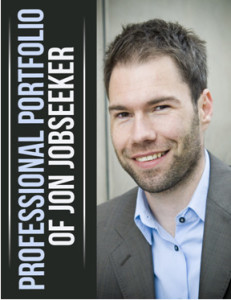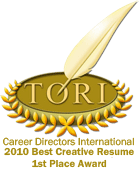 If a picture is truly worth 1,000 words, it’s worth your while to attend job interviews prepared to show and tell.
If a picture is truly worth 1,000 words, it’s worth your while to attend job interviews prepared to show and tell.
One of the best ways to do this is with a “brag book,” otherwise known as a portfolio, leave-behind, or interview presentation binder.
While portfolios are expected in certain “creative” professions, jobseekers in many more traditional fields could benefit from preparing a portfolio to use in an interview.
Why use a portfolio?
Putting together a portfolio is an excellent way to prepare for a job interview, as it can be used to reflect on the knowledge, skills, and abilities that will be most relevant for the targeted position.
A portfolio is also an excellent confidence booster. There’s just something about seeing all of your accomplishments in print that boosts your confidence and self-esteem.
A portfolio is useful in a job search to:
- Tangibly showcase your accomplishments.
- Document the breadth/depth of your educational credentials, training, and professional development.
- Set you apart from other candidates who are interviewed for the job.
- Give you a “prop” to make you more comfortable answering questions in the interview.
- Allow you to provide greater depth and detail about your qualifications than you can on the résumé alone.
Posting a portfolio online can help set you apart from other candidates in a competitive job market. You can link to your digital portfolio on your LinkedIn profile as well as provide a link to the portfolio on your résumé.
The portfolio is primarily designed to be used in the job interview — both to illustrate your qualifications and (possibly) as a leave-behind piece. Developing a customized portfolio for use as a leave-behind can be a very effective strategy. It shows you prepared for the interview.
A portfolio can also be used in your current job — for example, in a performance evaluation meeting or when requesting a raise and/or promotion.
Portfolios support your qualifications as a candidate. The purpose of the portfolio is to substantiate the information contained in your résumé and on your LinkedIn profile. Thus, your résumé and LinkedIn profile are the best place to start when compiling your portfolio.
Choosing the contents of your portfolio
How do you decide what to include in your portfolio?
- Review your résumé and identify any portfolio pieces that could substantiate your education, experience, training, or other qualifications.
- Think about the responsibilities of the position you are seeking. Are there any skills that the position requires that you want to showcase your experience with — for example, writing, photography, social media, or leadership?
Here are some of the kinds of things you can put in your portfolio:
Education/Training
- A copy of your college or university transcript.
- Copies of the certificates or diplomas for trainings/workshops/degrees listed on your résumé.
- Example of major class assignments — report, presentation, or project (for recent graduates).
- Documentation of knowledge of a foreign language (certificate, grade, or test result).
- Licenses.
Work-Related Documentation
- Performance evaluations (or excerpts of evaluations) from supervisors or managers.
- Work samples (projects, newsletters, photographs, case studies, proposals, surveys).
- Papers/reports/publications you’ve authored.
- Samples of communication/writing skills (writing samples).
- Evidence of computer/multimedia skills.
- Logs/lists/charts that document your performance.
- Sales information — but make sure you are not disclosing confidential information.
- 30-60-90 Day Plan — what you plan to do in the first 30, 60, and 90 days on the job in your new position.
Awards and Honors
- If you mentioned an award on the résumé, include a copy of the certificate or photo of the trophy.
- Photos of individual or team participation in an event or award.
- Scholarships received.
Feedback/Testimonials/Endorsements
- Include copies of any thank you letters you’ve received, including letters and emails from customers and/or co-workers.
- Letters of recommendation from previous supervisors and managers.
- List of references.
- LinkedIn Recommendations — you can either select a few and put one on each page, or put together a page of Recommendation excerpts.
Community or Organizational Involvement
- List of professional affiliations, including leadership roles.
- Clubs or activities you’re involved with.
- Photos of events you helped organize.
- Newspaper clippings featuring you at work or your involvement in charity work or with a nonprofit organization.
Other Documentation to Include
- Personal statement or philosophy.
- Résumé.
- LinkedIn summary.
- Career overview (bio or list of positions/dates).
- Photographs of you in action (on the job, or involved in volunteer activities).
- Photo of you delivering a presentation.
Related:
Create Your Own Interview Portfolio
How to Create an Online Portfolio
Also:
Ace the job Interview with a presentation
Answering those problem interview questions









Make copies to share. You should make copies of all the important materials an employer might want to keep from your portfolio, such as your resume and reference sheet. Alternatively, make multiple physical copies of your portfolio so you can leave it with the interviewer upon request. Update your portfolio periodically. Try to update your portfolio every few months or once a year. Revisiting your portfolio regularly will help you add relevant information while it s still current and remove outdated parts. It s also a useful way to review your progress and look for areas of improvement.